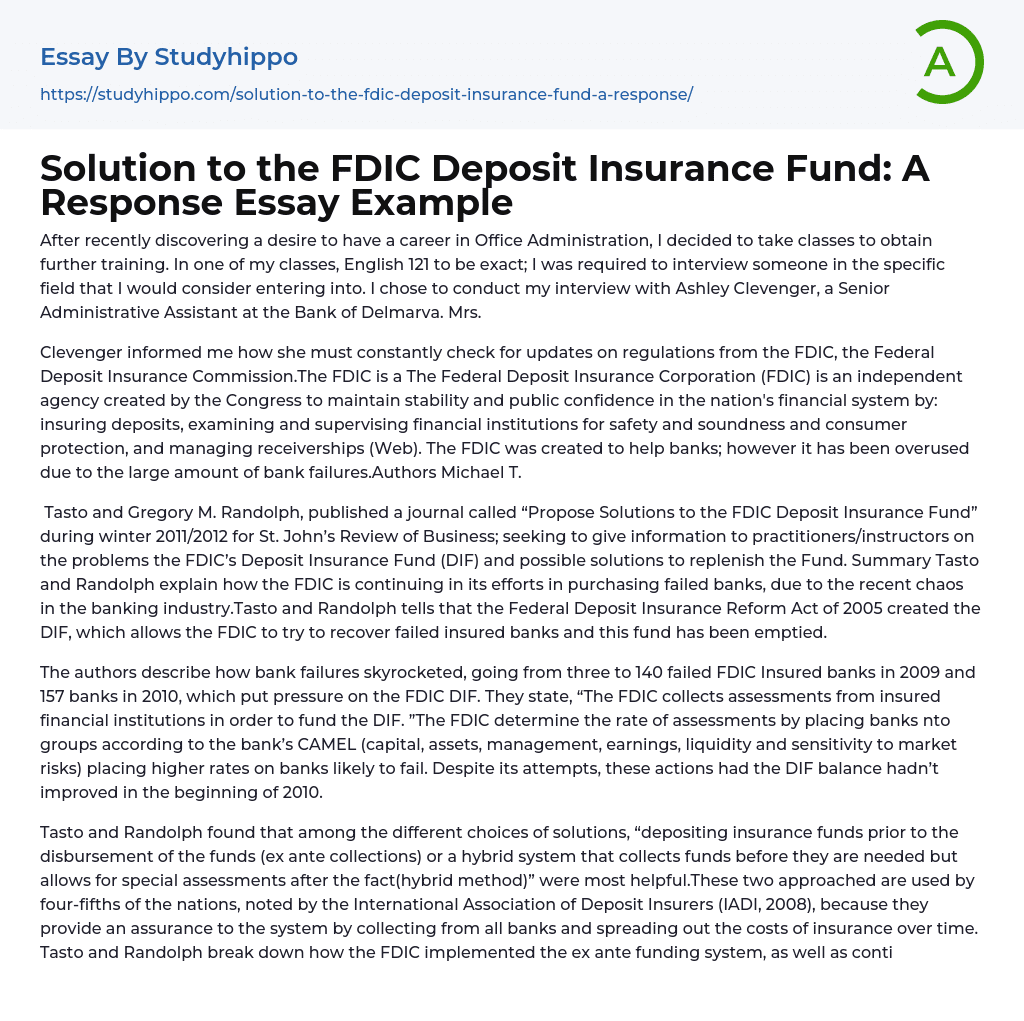

Solution to the FDIC Deposit Insurance Fund: A Response Essay Example
Having developed an interest in pursuing a career in Office Administration, I opted to enroll in relevant courses for additional training. During one such course, English 121, I was tasked with conducting an interview with someone working in the field I wished to enter. For this purpose, I chose Ashley Clevenger, a Senior Administrative Assistant employed at the Bank of Delmarva.
Clevenger explained that she needs to frequently monitor updates on regulations from the Federal Deposit Insurance Commission, also known as the FDIC. The FDIC, an independent agency established by Congress, is responsible for ensuring the stability and trustworthiness of the country's financial system, including deposit insurance, supervising and inspecting financial establishments for consumer protection and security, and managing receiverships (Web). Although originally intended to aid banks, the
...FDIC has been overworked due to the substantial number of bank collapses. Michael T.
During the winter of 2011/2012, Tasto and Gregory M. Randolph published a journal titled "Propose Solutions to the FDIC Deposit Insurance Fund" for St. John's Review of Business. Their aim was to provide practitioners/instructors with information on the problems faced by the FDIC's Deposit Insurance Fund (DIF) and potential solutions to replenish it. The article explains that the FDIC is actively purchasing failed banks in the wake of the recent chaos in the banking industry. Tasto and Randolph also point out that the DIF was created by the Federal Deposit Insurance Reform Act of 2005 to enable the FDIC to recuperate failed insured banks, but this fund has since been depleted.In their report, the authors note the significant increase in bank failures with a sharp rise from three to 140 failed FDIC
Insured banks in 2009, followed by 157 banks in 2010. This increase put considerable strain on the FDIC DIF. The authors acknowledge that the FDIC collects assessments from insured financial institutions to fund the DIF, and that the rate of assessments is determined by assigning banks to groups based on their CAMEL rating (capital, assets, management, earnings, liquidity and sensitivity to market risks). Banks considered more likely to fail are subjected to higher assessment rates. However, despite these efforts, the balance of the DIF remained stagnant at the start of 2010.
According to Tasto and Randolph, the most effective options for solutions are "ex ante collections" and a "hybrid method" which allow funds to be collected before they are needed, but also permit special assessments after the fact. The International Association of Deposit Insurers (IADI, 2008) notes that four-fifths of nations use these approaches because they ensure collection from all banks and distribute insurance costs over time, providing assurance to the system. The authors explain how the FDIC implemented the ex ante funding system and continued using the CAMEL rating system, but the issue was not completely resolved. They believe that although the FDIC has taken steps towards restoration, the damage requires an urgent injection of funds into the DIF and thorough evaluation of bank failure risk. Tasto and Randolph assert that further analysis will be necessary to prevent further failures, regardless of the solution chosen.
I concur with Tasto and Randolph's suggestions for addressing the FDIC DIF issue. Their report provided comprehensive insights into the status of FDIC DIF at the time of writing, including detailed graphical representations of the challenges facing the Deposit
Insurance Fund. Furthermore, their thesis statement effectively presented discussion questions for educators to use in their courses. By leveraging information from the International Association of Deposit Insurers, Tasto and Randolph's proposed solution was deemed trustworthy.
In my opinion, Tasto and Randolph should have presented the specific nations that used the solutions proposed by IADI along with relevant statistics. By presenting statistical graphs of each solution side by side, it would have been easier for instructors to visualize the solutions in action. In conclusion, there is no quick fix for restoring the FDIC fund, regardless of the method employed. Michael Tasto and Gregory Randolph, who are professors at Southern New Hampshire University, authored an article addressing potential solutions for replenishing the FDIC Deposit Insurance Fund. After perusing this article, I believe that instructors now possess a more comprehensive understanding of the state of the FDIC DIF, enabling them to hold informed discussions with their students.
- Commercial Bank essays
- Debit Card essays
- Deposit Account essays
- Subprime Lending essays
- Bank essays
- Banking essays
- Corporate Finance essays
- Credit Card essays
- Currency essays
- Debt essays
- Donation essays
- Enron Scandal essays
- Equity essays
- Financial Accounting essays
- Financial Crisis essays
- Financial News essays
- Financial Ratios essays
- Financial Services essays
- Forecasting essays
- Foreign Exchange Market essays
- Free Market essays
- Gold essays
- Investment essays
- Legacy essays
- Loan essays
- Market Segmentation essays
- Money essays
- Personal finance essays
- Purchasing essays
- Retirement essays
- Shareholder essays
- Stock Market essays
- Supply And Demand essays
- Venture Capital essays
- Aviation essays
- Emergency Management essays
- Health Insurance essays
- Insurance essays
- Life Insurance essays
- Public Transport essays
- Transportation essays



